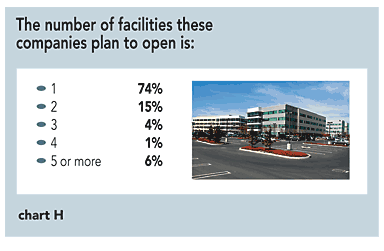6th Annual Consultants Survey Results
Dec/Jan 10

Clients Served
For the most part, less than a third of those responding to our 2009 Consultants Survey have worked on projects in any one manufacturing sector (Chart A). Again, since 65 percent of the respondents to our Corporate Survey are with manufacturing firms, the responses given by the consultants should differ from those given by the corporate executives. In fact, about 40 percent of the responding consultants have worked on warehouse/distribution projects (only 8 percent of the corporate respondents claimed to represent these types of operations), and 29 percent of the responding consultants have worked on projects in the financial services sector, which was represented by a mere 2 percent of the corporate respondents.
What services do these consultants provide? Thirty-seven percent of the responding consultants claimed to actually make their clients' site selection decisions. About a quarter also said they perform location studies/comparative analyses, incentives comparisons and negotiations, as well as help with real estate transactions (Chart B). Interestingly, more than two-thirds of the corporate executives who said they utilize the services of consultants said they use them to assist with real estate transactions.
Forty percent of the responding consultants said that those clients who ask them to perform a location search have actually already narrowed down the geographic area in which they wish to locate (Chart C), i.e., consultants are called in more toward the end of the site selection process.
In terms of size, those companies utilizing the services of the responding consultants are generally small to mid-size (fewer than 500 employees), as reported by 68 percent of the Consultants Survey respondents (Chart D).
Not surprisingly, more than half of the respondents to our 6th Annual Survey of Consultants said the downturn in the U.S. economy had caused their clients to put new facility plans on hold, and nearly half said their clients were deferring capital spending. About a third of the respondents also said their clients were closing/consolidating facilities (Chart E). These percentages are all greater than those reported in the responses to our 2009 Corporate Survey. Conversely, whereas only 6 percent of the responding consultants said their clients still plan to increase hiring, 22 percent of the respondents to the Corporate Survey said they still plan to increase hiring. Nevertheless, 46 percent of the respondents to our 2009 Consultants Survey think the economy will improve significantly in 2010 (Chart F), about the same percentage of corporate executives who think it will do so.
Clients' Facilities Plans
While only 34 percent of the respondents to our 2009 Corporate Survey said they plan to open new facilities within one to two years, three quarters of those responding to the Consultants Survey said their clients expect to open new facilities in one to two years (Chart G). This is another indication that the corporate executives who do use consultants do not engage them until they are further along in the location process. Additionally, this is still far fewer than the 88 percent of the respondents to our 2008 Consultants Survey who said their clients had similar one- to two-year new facility plans.
Further reflecting the economic downturn, only 26 percent of the responding consultants said their clients plan to open more than one new facility - down from 36 percent last year (Chart H). By comparison, 44 percent of the Corporate Survey respondents said they have plans for more than one new facility.
Many of the projects the 2009 Consultants Survey respondents' clients are working on are slated for the South (16 percent of the projects are expected to go to Alabama, Florida, Georgia, Louisiana, and Mississippi) and the Midwest (14 percent for Illinois, Indiana, Michigan, Ohio, and Wisconsin). It should be noted that only 10 percent of the projects reported by the Corporate Survey respondents were slated for the South. The Southwest (Arizona, New Mexico, Oklahoma, and Texas) is expected to garner 13 percent of their clients' new facilities, and the South Atlantic (North Carolina, South Carolina, Virginia, and West Virginia) will get some 12 percent of the projects (Chart I).
In line with their client representation as illustrated in Chart A, 29 percent of the new domestic facilities planned by the consultants' clients will house warehouse/distribution operations, with just 27 percent planned as manufacturing facilities (Chart J).
Project Announcements
Japan-Based Meiden America Switchgear Expands Gray Court, South Carolina, Production Operations
10/21/2025
Swiss-Based Ypsomed Plans Holly Springs, North Carolina, Manufacturing Operations
10/20/2025
AstraZeneca Plans Albemarle County, Virginia, Production Operations
10/20/2025
Circular Composite Solutions Plans Bamberg, South Carolina, Operations
10/20/2025
Keel Expands Charleston County, South Carolina, Operations
10/20/2025
Japan-Based Nidec Power Expands Lexington, Tennessee, Production Operations
10/19/2025
Most Read
-
2025’s Top States for Business: How the Winners Are Outpacing the Rest
Q3 2025
-
The Compliance Reckoning Is Here
Q3 2025
-
Around the Horn: Data Center Supply Chains — What's Next?
Q3 2025
-
Data Center Demand Stabilizes Amid Changing Market Forces
Q3 2025
-
How Consumer Trends Are Reshaping Food Facilities
Q3 2025
-
Powering the Next Generation of Projects
Q3 2025
-
First Person: Filter King’s Expansion Playbook
Q3 2025